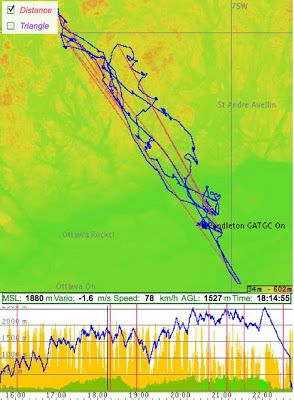You might wonder what keeps gliding interesting; it varies. Some like to instruct new people how to fly; some like aerobatics; some like to float around; and some like to challenge themselves to fly the greatest distance for the conditions of the day.
Some of the club members record their flights with GPS flight recorders, and post them to an online contest to compare how they did versus other pilots on the same day (www.onlinecontest.org). The club has had 40 flights by 13 pilots loaded (a slow start for the year due to the weather) in Canada, with a cumulative distance of just under 8,800 km. If you include flights in the US, 57 flights by 13 pilots, for 13,162 km - without engines! This puts us 33rd out of 159 clubs in North America (6th out of 24 in Canada).
Here are four examples from Sunday:
Nick, flying ST:
The top is a 2-D picture of the flight. It was about 440 km long. The bottom shows altitude, in metres, vs time (Universal - GMT). The green shows how the ground level changes (you can see the Gatineau hills). A flight to the Seaway, then up north of the Ottawa River.
Ron, flying Z9:
On Ron's flight, you can see the sensitive mic picking up the airstream noise on the graph in yellow - this is designed to detect engine runs in motorgliders. It was about 356 km.
Ulli, flying MZ:
Ulli started later in the day, but still went 321 km!
Finally, Rob, in one of the two-seaters, had a good flight in CZ.
You can see the drift from the wind as he circled to gain height (this is our equivalent of a gas station in the sky). The wind was from the north-west, up by the Ottawa River, and more westerly south of Pendleton.
On another flight, one of our pilots landed out at an airstrip just south of Maxville, Ontario, in one of the club's high performance gliders, an ASW-24 (it can glide about 10 km per 1,000' of altitude lost). The club sent one of our two towplanes to retrieve the glider from that airfield:
Photos are by Tom Hastie.
Towplane getting ready to tow the glider at the very nice airstrip.
Glider returning to Pendleton. We are trained and qualified to land at convenient airfields, or farmers' fields, before going cross-country... the slow approach speeds of the gliders mean you can land in very short fields.
You can also live physics while flying. For example, atmospheric pressure decreases with altitude... so if you close a water bottle at the airfield (260' above sea level), and open it 4,000' higher, water wants out... as seen below. Capture from a GoPro video camera...
The club is preparing to host the Canadian National Soaring Championship from 1-12 July. We hope to have glider pilots from across the country come to select a champion to represent Canada at the 2014 World Gliding Championship in Poland or Finland (two different classes). We may also get pilots from the US. Watch this space!







No comments:
Post a Comment